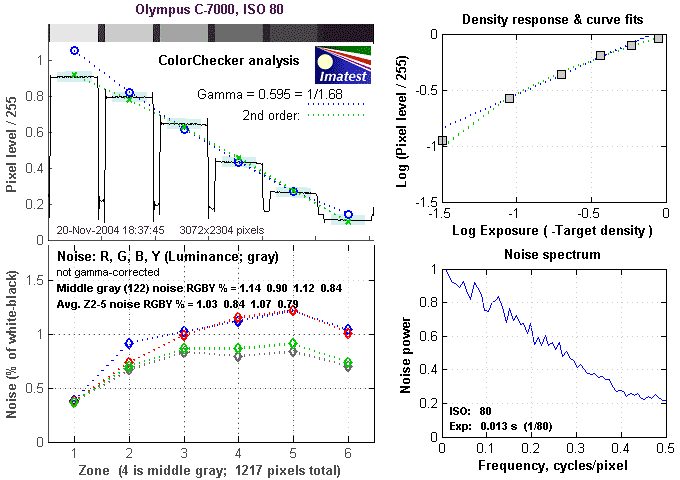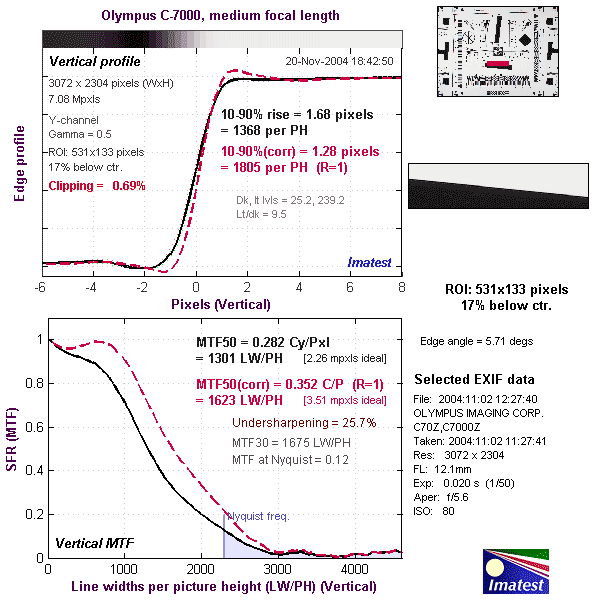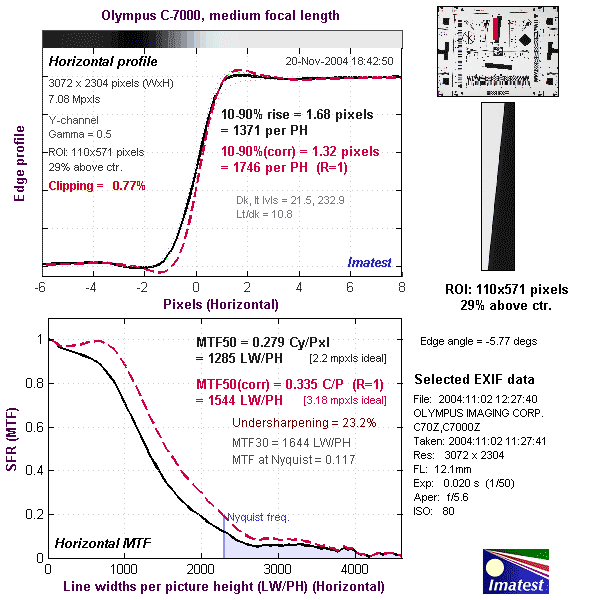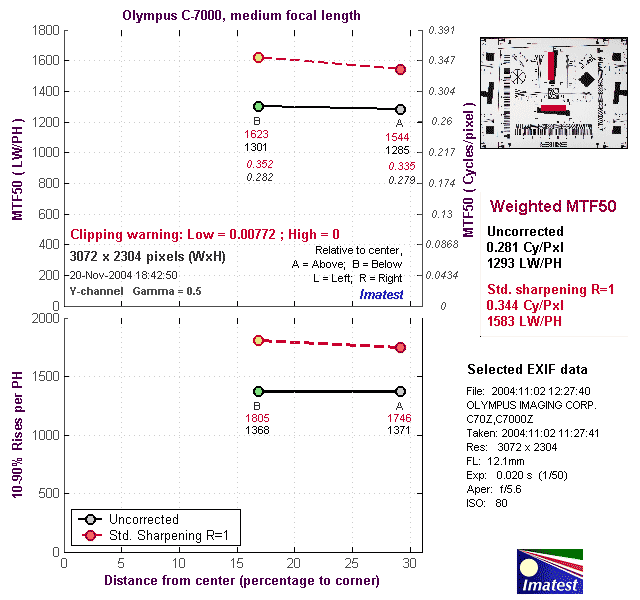Olympus C-7000 Wide ZoomSeven megapixels, 5x zoom, great pictures, a ton of features, and great build quality - A real winner!<<C-7000 Sample Images :(Previous) | (Next): Print-Friendly Review Version>> C-7000 Imatest ResultsReview First Posted: 11/26/04 |
Detailed analysis of the Olympus C-7000 Zoom images, from Imatest(tm)
I've recently begun using Norman Koren's excellent "Imatest" analysis program for quantitative, thoroughly objective analysis of digicam test images. I highly commend it to our technically-oriented readers, as it's far and away the best, most comprehensive analysis program I've found to date. (And with an introductory price of only $59, it's hard to beat.)
My comments below are just brief observations of what I see in the Imatest results. A full discussion of all the data Imatest produces is really beyond the scope of this review: Visit the Imatest web site for a full discussion of what the program measures, how it performs its computations, and how to interpret its output.
Here's some of the results produced by Imatest for the Olympus C-7000:
Color Accuracy
The Olympus C-7000 doesn't oversaturate its colors as much as most consumer/prosumer
cameras I test. This has led some reviewers to mark it down for more dull-looking
color, but its color is in fact more accurate than most cameras on the market.
(It does produce rather dull-looking bright yellows though.) Being accurate
doesn't do you any good though, if what everyone wants is bright, snappy-looking
color. Fortunately, the C-7000's color saturation control lets you tweak the
color up exactly the amount you want. The saturation control has nice, fine
adjustment steps that cover a broad range. If you want the C-7000's color
to look more like that of other cameras on the market, try just leaving the
saturation control boosted one or two notches. On average, color saturation
of swatches on the MacBeth ColorChecker(tm) chart are 102.9% of their ideal
values. (An average oversaturation of 2.9%.)
Color Analysis
These images show the color behavior of the C-7000 directly. In each color
swatch, the outer perimeter shows the color as actually captured by the camera,
the inner square shows the color after correcting for the luminance of the photographed
chart (as determined by a 2nd-order curve fit to the values of the gray swatches),
and the small rectangle inside the inner square shows what the color should
actually be, based on perfect rendering to the sRGB color spacer. From this
plot, we can see how close the C-7000's color is to the ideal values across
much of the spectrum. The major deviation is the rather dark yellow it produces
here.
Gray Patch Tone and Noise Analysis

There's a lot in this particular graph, a lot more than I have room to go into
here. Bottom line, the Olympus C-7000's noise levels are right in line with
those of the best competing 7-megapixel cameras, with a nice, fine-grained character.

This chart compares the C-7000's noise performance over a range of ISOs against
that of competing cameras. As you can see, the C-7000 and Sony DSC-V3 have very
similar performance, the Sony DSC-P150 coming in just a hair lower. Despite
the low noise levels in its final images, the C-7000 does a good job of maintaining
subject detail in areas of subtle contrast. An excellent performance overall.
The chart above shows consolidated results from spatial frequency response
measurements in both the horizontal and vertical axes. The "MTF 50"
numbers tend to correlate best with visual perceptions of sharpness, so those
are what I focus on here. The uncorrected resolution figures are 1285 line widths
per picture height in the horizontal direction (corresponding to the vertically-oriented
edge), and 1301 along the vertical axis (corresponding to the horizontally-oriented
edge), for a combined average of 1293 LW/PH. Correcting to a "standardized"
sharpening with a one-pixel radius increases this number slightly, to an average
of 1583 LW/PH, an excellent number that's better than some 8-megapixel cameras
manage.
For the real techno-geeks, the two plots below show the actual edge response
of the C-7000, for horizontal and vertical edge. What's interesting in these
plots is how restrained the C-7000's default sharpening is, and how little it
disturbs the underlying image detail. There's really no over-sharpening at all.
This has led some to mark its images off for being soft, but here again, the
camera's image-adjustment controls work very well. - Just dial up the sharpness
setting a couple of notches.




Follow Imaging Resource: